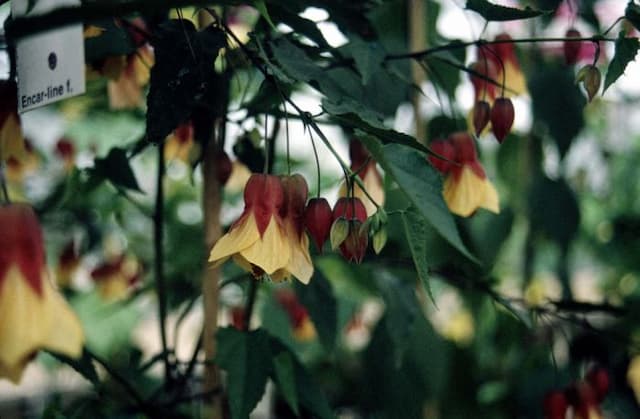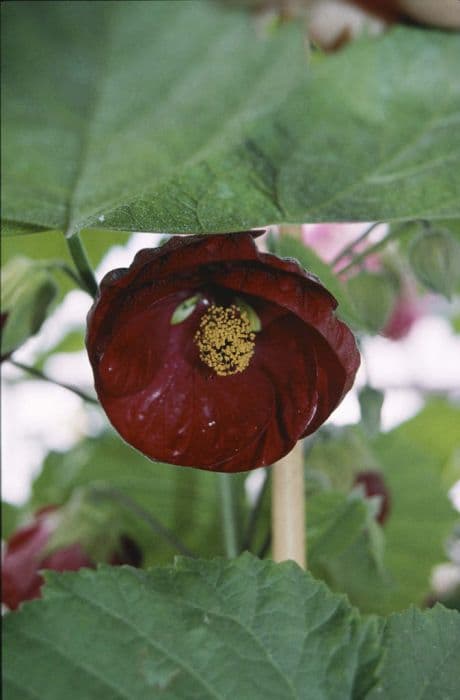Flowering Maple Abutilon 'Souvenir de Bonn' (v)

ABOUT
'Souvenir de Bonn' is a striking ornamental plant known for its unique foliage and attractive blooms. The plant bears heart-shaped leaves variegated with a blend of green and creamy white or yellow margins, creating a striking contrast. Between these variegated leaves, abundant bell-shaped flowers hang gracefully. These blooms typically display a soft orange to salmon color, which adds a warm, tropical feel to any setting. The leaves have a somewhat velvety texture, which lends a lush appearance to the plant. When in bloom, 'Souvenir de Bonn' provides a delightful display with the combination of its two-toned foliage and the gentle, pendulous flowers that give the plant a cottage garden appeal. The overall impression of 'Souvenir de Bonn' is that of a vibrant and cheerful plant that can add both color and texture to any garden space.
About this plant
 Names
NamesFamily
Malvaceae.
Synonyms
Flowering Maple, Chinese Lantern.
Common names
Abutilon 'Souvenir de Bonn'.
 Toxicity
ToxicityTo humans
Flowering Maple, which is a common name for Abutilon 'Souvenir de Bonn', is not known to be toxic to humans. There is no significant toxicity associated with the ingestion of this plant, and it should not cause any symptoms of poisoning if consumed in typical amounts found in the household or garden context. However, it is generally recommended not to eat plants that are not known to be edible as they might cause gastrointestinal discomfort or allergic reactions in some individuals.
To pets
Flowering Maple is not listed as a toxic plant to pets such as dogs and cats. There should be no toxicity associated with pets ingesting the leaves or flowers of this variety of Abutilon. As with humans, while it isn't expected to cause serious illness, ingestion by pets might result in mild gastrointestinal upset simply due to the consumption of non-digestible plant matter. Always monitor your pets and contact a veterinarian if you observe any unusual symptoms after ingestion.
 Characteristics
CharacteristicsLife cycle
Perennials
Foliage type
Evergreen
Color of leaves
Variegated
Flower color
Orange
Height
5-6 feet (1.5-1.8 meters)
Spread
3-5 feet (0.9-1.5 meters)
Plant type
Shrub
Hardiness zones
9
Native area
South America
Benefits
 General Benefits
General Benefits- Attractive Foliage: It has variegated leaves that add visual interest to any garden or indoor space.
- Flowering Plant: Produces bell-shaped flowers which can enhance the aesthetic appeal of its surroundings.
- Habitat for Wildlife: Can attract pollinators such as bees and hummingbirds, supporting local ecosystems.
- Versatile Location: Suitable for planting in a variety of locations, including borders, flowerbeds, and containers.
- Low Maintenance: Requires minimal care once established, making it ideal for gardeners of all skill levels.
- Tolerates Partial Shade: Can thrive in areas that do not receive full sunlight, increasing its versatility in landscape design.
- Fast Growing: Quick to reach maturity, which is beneficial for those who want to establish a garden in a short amount of time.
 Medical Properties
Medical PropertiesThis plant is not used for medical purposes.
 Air-purifying Qualities
Air-purifying QualitiesThis plant is not specifically known for air purifying qualities.
 Other Uses
Other Uses- Textile Fiber Source: The stems of Flowering Maple can be processed to extract fibers that are used in paper and textile industries, offering an alternative to more traditional fiber crops.
- Livestock Fodder: In some regions, the leaves of Flowering Maple can be fed to livestock as part of their diet, especially in areas where other fodder sources are scarce.
- Natural Insecticide: Extracts from Flowering Maple leaves can be used as a natural insect repellent for protecting crops or as an ingredient in organic pesticides.
- Photography: The distinctive patterns and bright colors of Flowering Maple flowers can provide a beautiful backdrop or subject for photographers and visual artists.
- Culinary Garnish: The flowers, while not commonly consumed, can be used as an ornamental garnish for plating high-end cuisine, adding an exotic touch to dishes.
- Dye Production: The flowers and leaves may be used to produce natural dyes for coloring fabrics or crafting supplies, offering a range of subtle colors.
- Educational Tool: Flowering Maple can be used in educational settings to teach students about plant biology, hybridization, and the importance of plant diversity.
- Horticultural Therapy: The plant's care requirements and attractive appearance make it suitable for horticultural therapy programs, where gardening facilitates healing and rehabilitation.
- Windbreaks: In outdoor gardens, Flowering Maple can be planted in a row to create a visual barrier or windbreak protecting more sensitive plants.
- Bee-keeping: As a nectar source, Flowering Maple can help support local bee populations, which are crucial for pollination in gardens and agriculture.
Interesting Facts
 Feng Shui
Feng ShuiThe Flowering Maple is not used in Feng Shui practice.
 Zodiac Sign Compitability
Zodiac Sign CompitabilityThe Flowering Maple is not used in astrology practice.
 Plant Symbolism
Plant Symbolism- Beauty and Uniqueness - The striking variegated foliage and colorful bell-shaped flowers of the 'Souvenir de Bonn' abutilon, commonly known as Flowering Maple, symbolize beauty and uniqueness, as its appearance is quite distinctive and not easily found in every garden.
- Warmth and Shelter - Flowering Maple plants are often found in warm climates and indoors, providing a sense of protection and comfort which can symbolize shelter and a haven for growth.
- Intrigue - The unusual patterns and shapes of the Flowering Maple's leaves and flowers can symbolize mystery or intrigue, inviting onlookers to take a closer look.
 Water
WaterThe Flowering Maple should be watered regularly, aiming to keep the soil consistently moist but not waterlogged. In general, it's good to water thoroughly when the top inch of the soil feels dry to the touch, which could mean watering once a week, but this can vary depending on environment and pot size. When watering, slowly pour water onto the soil until it begins to run out of the drainage holes, ensuring the roots have adequate moisture. During active growing seasons, spring and summer, it might need more frequent watering. In the winter, reduce watering but don't allow the soil to completely dry out.
 Light
LightProviding bright, indirect light is best for the Flowering Maple. A spot near an east or south-facing window where it can receive ample, but filtered, sunlight would be ideal. Direct afternoon sun can be too intense and may cause leaf scorch, so avoid placing it in harsh direct sunlight for extended periods of time.
 Temperature
TemperatureThe Flowering Maple thrives in temperatures between 60 and 75 degrees Fahrenheit. It can tolerate a low of 50 degrees Fahrenheit and a high up to 80 degrees Fahrenheit but should be protected from drafts and extreme temperature fluctuations. The ideal conditions would mimic its natural subtropical habitat, with warmer days and cooler nights.
 Pruning
PruningPruning the Flowering Maple promotes bushier growth and can help maintain its shape. Prune in late winter or early spring before new growth begins by trimming back leggy branches and removing any dead or yellowing leaves. Occasional pruning throughout the growing season can also be done to remove faded flowers and encourage more blooms.
 Cleaning
CleaningAs needed
 Soil
SoilFlowering Maple requires well-draining soil rich in organic matter with a slightly acidic to slightly alkaline pH between 6.0 and 7.5. A good soil mix would be equal parts of loam, peat or coco coir, and perlite or sand to ensure proper drainage and aeration.
 Repotting
RepottingFlowering Maples should be repotted every 2 to 3 years, ideally during spring before the onset of the growth season. If the plant is growing vigorously, annual repotting may be necessary to provide fresh soil and room for the roots to expand.
 Humidity & Misting
Humidity & MistingFlowering Maple prefers moderate to high humidity levels, maintaining 50-60% humidity is ideal for optimal growth. Avoid placing it in excessively dry environments.
 Suitable locations
Suitable locationsIndoor
Ensure bright, indirect light and keep the plant away from drafts.
Outdoor
Place in partial shade, sheltered from strong winds.
Hardiness zone
9-11 USDA
 Life cycle
Life cycleFlowering Maple 'Souvenir de Bonn' begins its life as a seed that germinates in warm, moist soil, where it develops its first roots and leaves as a seedling. As it matures into a young plant, it establishes more leaves and stems, growing steadily in favorable conditions of partial shade and well-draining soil. It enters a vegetative state where the focus is on leaf and stem growth until it's mature enough to start budding. The plant then produces its striking flowers, usually during the warmer months, which can be orange, red, or pink, often with a bell shape and prominent veins. After pollination, typically by insects, it develops seed pods that, when mature, release seeds for the next generation. Throughout its life, this perennial can experience numerous flowerings and seed settings, assuming it receives proper care including regular watering and feeding.
 Propogation
PropogationPropogation time
Spring-Early Summer
The Flowering Maple, scientifically known as Abutilon 'Souvenir de Bonn', can be propagated most effectively through stem cuttings. This method is best carried out in late spring or early summer when the plant is actively growing. To propagate, one would take a healthy stem about 4 to 6 inches (10 to 15 centimeters) long, ensuring it has at least two sets of leaves. The bottom set of leaves is removed, and the cut end is dipped in rooting hormone to encourage root development. The prepared cutting is then placed in a moist potting mix, with the remaining leaves above the soil surface. The pot should be kept in a warm spot with indirect light and covered with a plastic bag to maintain humidity until roots develop, usually in a few weeks. Once rooted, the new Flowering Maple plants can be transplanted into individual pots and will grow into replicas of the parent plant.









